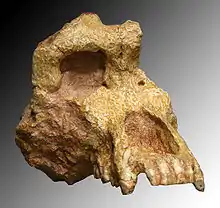Ouranopithecus
Ouranopithecus is a genus of extinct Eurasian great ape represented by two species, Ouranopithecus macedoniensis, a late Miocene (9.6–8.7 mya) hominoid from Greece[1] and Ouranopithecus turkae, also from the late Miocene (8.7–7.4 mya) of Turkey.[2]
| Ouranopithecus | |
|---|---|
 | |
| Ouranopithecus macedoniensis skull in the French National Museum of Natural History, Paris | |
| Scientific classification | |
| Kingdom: | Animalia |
| Phylum: | Chordata |
| Class: | Mammalia |
| Order: | Primates |
| Suborder: | Haplorhini |
| Infraorder: | Simiiformes |
| Family: | Hominidae |
| Subfamily: | Homininae |
| Tribe: | †Graecopithecini |
| Genus: | †Ouranopithecus Bonis & Melentis, 1977 |
| Species | |
Systematics
Based on O. macedoniensis' dental and facial anatomy, it has been suggested that Ouranopithecus was actually a dryopithecine. However, it is probably more closely related to the Ponginae.[3][4] Some researchers consider O. macedoniensis to be the last common ancestor of apes and humans,[5] and a forerunner to australopithecines and humans,[6] although this is very controversial and not widely accepted. It is true that O. macedoniensis shares derived features with some early hominins (such as the frontal sinus, a cavity in the forehead), but they are almost certainly not closely related species.[7] It has been suggested that it may be a synonym of Graecopithecus freybergi,[8] although there is not enough data to support the synonymy.[9]
See also
- Anoiapithecus – Extinct genus of ape from the Miocene
- Chororapithecus – Extinct hominine genus from the Miocene
- Dryopithecus – Extinct great ape from Europe
- Nakalipithecus – Extinct species of ape from Miocene Kenya
- Pierolapithecus – Extinct species of ape from Miocene Europe
- Samburupithecus – Extinct genus of primate from Miocene Kenya
References
- de Bonis, Louis; Melentis, J (1977). "Les primates hominoides du Vallesien de Macedoine (Grece): etude de la machoine inferieure". Geobios. 10 (6): 849–855. doi:10.1016/s0016-6995(77)80081-8.
- Gulec, Erksin S.; et al. (2007). "A new great ape from the lower Miocene of Turkey". Anthropological Science. 115 (2): 153–158. doi:10.1537/ase.070501.
- Alba, D.M.; Fortuny, J.; Moya-Sola, S.; et al. (2010). "Enamel thickness in the middle Miocene great apes Anoiapithecus, Picrolapithecus and Dryopithecus". Proceedings of the Royal Society B: Biological Sciences. 277 (1691): 2237–2245. doi:10.1098/rspb.2010.0218. PMC 2880156. PMID 20335211.
- Begun, David R. (2005). "Relations among great apes and humans: New interpretations based on the fossil great ape Dryopithecus". American Journal of Physical Anthropology. 37: 11–63. doi:10.1002/ajpa.1330370604.
- de Bonis, Louis; et al. (1990). "New hominoid skull material from the late Miocene of Macedonia in Northern Greece". Nature. 345 (6277): 712–4. Bibcode:1990Natur.345..712D. doi:10.1038/345712a0. PMID 2193230.
- de Bonis, Louis; Koufos, George D. (2004). "Ouranopithecus and dating the splitting of extant hominoids". Comptes Rendus Palevol. 3 (4): 257–264. doi:10.1016/j.crpv.2004.04.002.
- de Bonis, Louis; et al. (1981). "Dental metric variation in early Hominids comparison between Australopithecus afarensis and Ouranopithecus macedoniensis". Comptes Rendus des Séances de l'Académie des Sciences. Serie III Sciences de la Vie. 292: 263–266.
- Andrews, Martin L. (1984). "The phylogenetic position of Graeceopithecus freybergi Koenigswald". Courier Forschungsinstitut Senckenberg. 69: 25–40.
- Koufos, George D.; de Bonis, Louis (2005). "The late Miocene Hominoids Ouranopithecus and Graeceopithecus. Implications about their relationships and taxonomy". Annales de Paléontologie. 91 (3): 227–240. doi:10.1016/j.annpal.2005.05.001.
External links
| Wikimedia Commons has media related to Ouranopithecus. |
- Human Timeline (Interactive) – Smithsonian, National Museum of Natural History (August 2016).